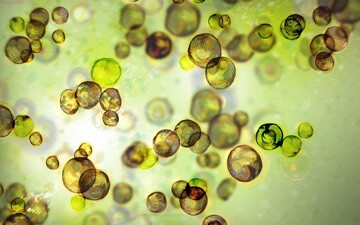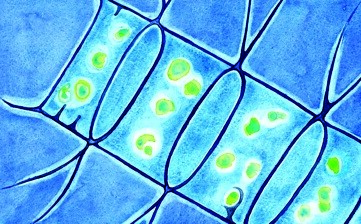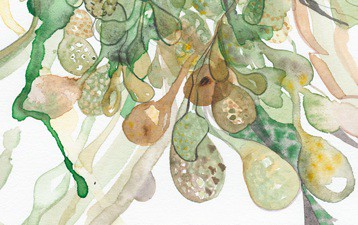For best results print the cards using the Firefox Browser
Cards
(QUICK LINKS: Decks | plants | mammals | birds | | reptiles | fish | cephalopoda | insects | microbe | events
( scientist | project | modifier | technique |)

Zooxanthellae
Symbiodinium spp.


Sorry, there is no photo available. If you have one, please submit
here
.
3 POINTS
• ZOOXANTHELLAE is a PLANKTON SPECIES.
• ZOOXANTHELLAE must be present to play WARM WATER CORAL SPECIES (SYMBIOTIC relationship).
cool, warm
Graphic by Nadir Balansci-ence.org
Zooxanthellae ( /ˌzoʊ.əzænˈθɛliː/) are flagellate protozoa from the genus Symbiodinium that are golden-brown intracellular endosymbionts of various marine animals andprotozoa, especially anthozoans such as the scleractinian corals and the tropical sea anemone, Aiptasia. Zooxanthellae live in other protozoa (foraminiferans and radiolarians) and in some invertebrates. Most are autotrophs and provide the host with energy in the form of translocated reduced carbon compounds, such as glucose, glycerol, […] read more

Diatom
Chaetocerus spp.


Sorry, there is no photo available. If you have one, please submit
here
.
3 POINTS
• Prochlorococcus spp. is a PLANKTON SPECIES.
cool, warm
Graphic by Melissa Guionwww.melissaguion.com
Chaetoceros is probably the largest genus of marine planktonic diatoms with approximately 400 species described. Although a large number of these descriptions are no longer valid. It is often very difficult to distinguish between different Chaetocerosspecies.[1] Several attempts have been made to restructure this large genus into subgenera and this work is still in progress[2][3]However, most of […] read more

Cyanobacteria
Tolypothrix spp.


Sorry, there is no photo available. If you have one, please submit
here
.
2 POINTS
Play: Tolypothrix spp. is a PLANKTON SPECIES.
cool, warm, hot
Graphic by Emilie Clarkwww.emilieclark.com
Cyanobacteria /saɪˌænoʊbækˈtɪəriə/, also known as Cyanophyta, is a phylum of bacteria that obtain their energy through photosynthesis.[3] The name “cyanobacteria” comes from the color of the bacteria (Greek: κυανός (kyanós) = blue). They are often called blue-green algae, but some consider that name a misnomer as cyanobacteria are prokaryotic and algae should be eukaryotic,[4] although other definitions of algae encompass prokaryotic organisms.[5] By producing oxygen as a gas as a by-product of photosynthesis, cyanobacteria are thought […] read more

Coralline algae
Porolithon spp.


Sorry, there is no photo available. If you have one, please submit
here
.
3 POINTS
• Porolithon spp. is an ALGAE and PLANKTON SPECIES.
cool, warm
Graphic by Emilie Clarkwww.emilieclark.com
Coralline algae are red algae in the order Corallinales. They are characterized by a thallus that is hard because of calcareousdeposits contained within the cell walls. The colors of these algae are most typically pink, or some other shade of red, but other species can be purple, yellow, blue, white or gray-green. Coralline algae play an important role in the ecology […] read more

Maiden’s Hair
Chlorodesmis fastigiata



3 POINTS
• Chlorodesmis fastigiata is an ALGAE and PLANKTON SPECIES.
• It is also OPPORTUNISTIC and may be played on top of other PLANKTON cards (discard other PLANKTON card)
warm
Graphic by Nadir Balansci-ence.org
Photo by eol.orgeol.org
In taxonomy, Chlorodesmis is a genus of algae, specifically of the Udoteaceae.[1] Algae in this genus produce the toxic diterpene chlorodesmin to defend themselves against generalist herbivores[2] (From Wikipedia, May 31st, 2012) read more

Brown macroalgae
Sargassum spp.


Sorry, there is no photo available. If you have one, please submit
here
.
3 POINTS
• Sargassum spp. is an ALGAE and PLANKTON SPECIES.
cool, warm
Graphic by Emilie Clarkwww.emilieclark.com
Sargassum is a genus of brown (class Phaeophyceae) macroaldga (seaweed) in the order Fucales. Numerous species are distributed throughout the temperate and tropical oceans of the world, where they generally inhabit shallow water and coral reefs. However, the genus may be best known for its planktonic (free-floating) species. While most species within the class Phaeophyceae are predominantly cold […] read more